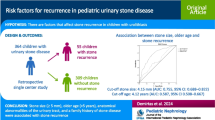Abstract
The administration of ceftriaxone is known to be associated with biliary pseudolithiasis, although the development of urolithiasis has only rarely been reported. We treated a young male with bacterial meningitis complicated by urinary precipitates composed of ceftriaxone–calcium salt, which prompted us to study whether ceftriaxone administration predisposes children to the formation of urinary precipitates. The case–control study reported here included 83 children with bacterial pneumonia aged from 3 months to 8.9 years. The children were divided into one group of 43 children who received ceftriaxone (group A) and a second group of 40 children who received amoxicillin (group B). Paired samples of serum and urine before and after treatment were obtained from the patients in each group. There were no significant differences in demographic characteristics and blood biochemistry between the groups. However, the mean urinary calcium to creatinine ratio (uCa/Cr; mg/mg) was significantly higher in group A patients than in group B patients after treatment (0.19 vs. 0.09, respectively; p < 0.001), and analysis of the paired urine samples revealed that the uCa/Cr significantly increased after treatment only in group A patients(p < 0.001). There was a weak but non-significant relationship between the dose of ceftriaxone and the uCa/Cr in group A (p = 0.10, r = 0.24). Our results are the first to demonstrate that ceftriaxone has the potential to significantly increase urinary excretion of calcium, which may be linked to ceftriaxone-related urolithiasis or sludge. We therefore suggest that it is worthwhile monitoring the uCa/Cr levels in patients on ceftriaxone as they may be at greater risk for developing large stones and renal damage.

Similar content being viewed by others
References
de Moor RA, Egberts AC, Schröder CH (1999) Ceftriaxone-associated nephrolithiasis and biliary pseudolithiasis. Eur J Pediatr 158:975–977
Schaad UB, Suter S, Gianella-Borradori A, Pfenninger J, Auckenthaler R, Bernath O, Cheseaux JJ, Wedgwood J (1990) A comparison of ceftriaxone and cefuroxime for the treatment of bacterial meningitis in children. N Engl J Med 322:141–147
Palanduz A, Yalçin I, Tonguç E, Güler N, Oneş U, Salman N, Somer A (2000) Sonographic assessment of ceftriaxone-associated biliary pseudolithiasis in children. J Clin Ultrasound 28:166–168
Bor O, Dinleyici EC, Kebapci M, Aydogdu SD (2004) Ceftriaxone-associated biliary sludge and pseudocholelithiasis during childhood: a prospective study. Pediatr Int 46:322–324
Acun C, Erdem LO, Söğüt A, Erdem CZ, Tomaç N, Gündoğdu S, Cavuldak S (2004) Gallbladder and urinary tract precipitations associated with ceftriaxone therapy in children: a prospective study. Ann Trop Paediatr 24:25–31
Gargollo PC, Barnewolt CE, Diamond DA (2005) Pediatric ceftriaxone nephrolithiasis. J Urol 173:577–578
Mohkam M, Karimi A, Gharib A, Daneshmand H, Khatami A, Ghojevand N, Sharifian M (2007) Ceftriaxone associated nephrolithiasis: a prospective study in 284 children. Pediatr Nephrol 22:690–694
Avci Z, Koktener A, Uras N, Catal F, Karadag A, Tekin O, Degirmencioglu H, Baskin E (2004) Nephrolithiasis associated with ceftriaxone therapy: a prospective study in 51 children. Arch Dis Child 89:1069–1072
Sargent JD, Stukel TA, Kresel J, Klein RZ (1993) Normal values for random urinary calcium to creatinine ratios in infancy. J Pediatr 123:393–397
Shiffman ML, Keith FB, Moore EW (1990) Pathogenesis of ceftriaxone-associated biliary sludge. In vitro studies of calcium-ceftriaxone binding and solubility. Gastroenterology 99:1772–1778
Nakai Y, Tokuyama E, Yoshida M, Uchida T (2010) Prediction of incompatibility of ceftriaxone sodium with calcium ions using the ionic product. Yakugaku Zasshi 130:95–102
Cochat P, Cochat N, Jouvenet M, Floret D, Wright C, Martin X, Vallon JJ, David L (1990) Ceftriaxone-associated nephrolithiasis. Nephrol Dial Transplant 5:974–976
Bonnet JP, Abid L, Dabhar A, Lévy A, Soulier Y, Blangy S (2000) Early biliary pseudolithiasis during ceftriaxone therapy for acute pyelonephritis in children: a prospective study in 34 children. Eur J Pediatr Surg 10:368–371
Papadopoulou F, Efremidis S, Karyda S, Badouraki M, Karatza E, Panteliadis C, Malaka K (1999) Incidence of ceftriaxone-associated gallbladder pseudolithiasis. Acta Paediatr 88:1352–1355
Schaad UB, Wedgwood-Krucko J, Tschaeppeler H (1988) Reversible ceftriaxone-associated biliary pseudolithiasis in children. Lancet 8625:1411–1413
Biner B, Oner N, Celtik C, Bostancioğlu M, Tunçbilek N, Güzel A, Karasalihoğlu S (2006) Ceftriaxone-associated biliary pseudolithiasis in children. J Clin Ultrasound 34:217–2122
Stojanovic V, Djuric Vijatov G (2009) Nephrolithiasis caused by ceftriaxone in a 3-year-old child with ureteropelvic junction obstruction. Case Report Med 2009:365962
Portale AA (2004) Calcium and phosphorus. In: Avner ED, Harmon WE, Niaudet P (eds) Pediatric nephrology, 5th edn. Lippincott Williams & Wilkins, Philadelphia
Acknowledgment
This study was partly supported by the Mami Mizutani Foundation.
Conflict of interest
None.
Author information
Authors and Affiliations
Corresponding author
Rights and permissions
About this article
Cite this article
Kimata, T., Kaneko, K., Takahashi, M. et al. Increased urinary calcium excretion caused by ceftriaxone: possible association with urolithiasis. Pediatr Nephrol 27, 605–609 (2012). https://doi.org/10.1007/s00467-011-2038-z
Received:
Revised:
Accepted:
Published:
Issue Date:
DOI: https://doi.org/10.1007/s00467-011-2038-z




